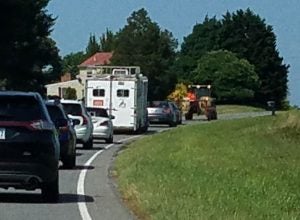While a tractor’s natural habitat may be in a farm field, many people ask: Are tractors allowed on the road? It’s a valid question as the often slow-moving machines can take up a lot of space on two-lane public pavement.
The simple answer is, yes, they are allowed. The longer answer includes many rules and regulations and a lot of legal variations state-to-state, but that also ends in a yes.
Since don’t use public roads as frequently as automobiles do and don’t get stolen as often, farm tractors don’t have the same title and registration requirements that many people are used to and they have more lenient regulations compared with construction tractors. (For some farm vehicles, such as trucks, a farm/company name and the United States Department of Transportation (USDOT) number has be displayed.)
Because so many farm tractors move at fewer than 25 mph and often have attachments that are 15 feet wide (though they can be more), safety is a primary concern and is the reason so many regulations are in place. There are about 15,000 collisions involving farm vehicles on U.S. roadways each year, according to National Safety Council estimates. The more farmers and motorists who can exercise caution and share the road appropriately, the better to prevent injuries and fatalities.


Many states have specific lights and markings that are required on tractors while on the road — these can include at least one front white light as well as a rear red light that’s visible for up to 500 feet.
It is illegal (not to mention dangerous!) to go around even the slowest-moving vehicles in a no-passing zone, and if a tractor is slowing down to turn, motorists should, under no circumstances, try to go around the tractor as it might be unclear which direction the tractor is turning and implements towed behind the vehicle can swing wide or create other unexpected hazards for cars.
Here is a long list of safety measures to be aware of from the National Ag Safety Database.
But while these safety measures for tractors on the road can be applied rather broadly, there are those rules that vary based on what state you’re in. For example, the slow-moving vehicle (SMV) sign — that solid orange triangle during the day which appears as a hollow red triangle at night — seems to be common sense on tractors, especially ones going less than 25 mph. But there are some states, such as North Carolina, that don’t make it a requirement to have one — though it is encouraged.
Some states also make it illegal for farm machinery to be driven on public roads after dark, because no matter how many flashers are on a vehicle, it’s amazingly difficult to gauge how quickly a car going 60 mph will be on top of a slow-moving tractor. It’s a recipe for disaster.
Bottom line: Share the road responsibly. Tractors are allowed to be out there and have a genuine need to use public roads to get from farm to farm or to more remote areas of a single farm property. The goal for farmers should be to make their machines as visible as possible.
And lastly, every farmer should check his/her insurance policy to make sure it includes coverage for driving a tractor off of the farm property.


